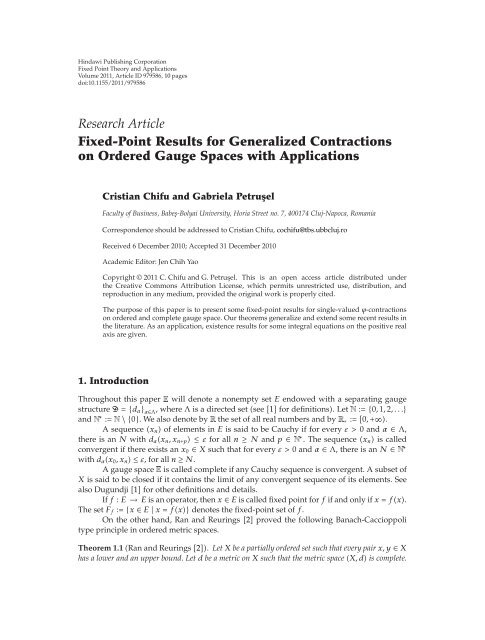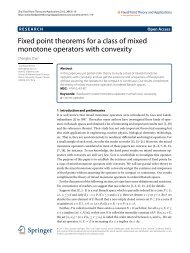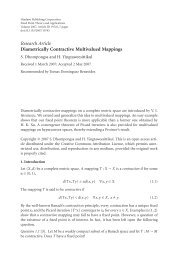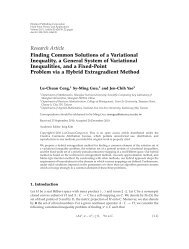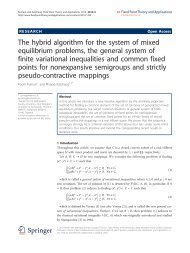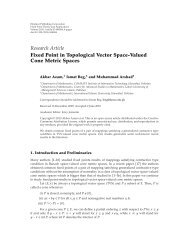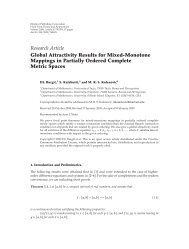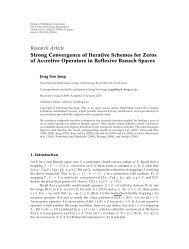Full-Text PDF - European Mathematical Society
Full-Text PDF - European Mathematical Society
Full-Text PDF - European Mathematical Society
You also want an ePaper? Increase the reach of your titles
YUMPU automatically turns print PDFs into web optimized ePapers that Google loves.
Hindawi Publishing Corporation<br />
Fixed Point Theory and Applications<br />
Volume 2011, Article ID 979586, 10 pages<br />
doi:10.1155/2011/979586<br />
Research Article<br />
Fixed-Point Results for Generalized Contractions<br />
on Ordered Gauge Spaces with Applications<br />
Cristian Chifu and Gabriela Petrus¸el<br />
Faculty of Business, Babes¸-Bolyai University, Horia Street no. 7, 400174 Cluj-Napoca, Romania<br />
Correspondence should be addressed to Cristian Chifu, cochifu@tbs.ubbcluj.ro<br />
Received 6 December 2010; Accepted 31 December 2010<br />
Academic Editor: Jen Chih Yao<br />
Copyright q 2011 C. Chifu and G. Petrus¸el. This is an open access article distributed under<br />
the Creative Commons Attribution License, which permits unrestricted use, distribution, and<br />
reproduction in any medium, provided the original work is properly cited.<br />
The purpose of this paper is to present some fixed-point results for single-valued ϕ-contractions<br />
on ordered and complete gauge space. Our theorems generalize and extend some recent results in<br />
the literature. As an application, existence results for some integral equations on the positive real<br />
axis are given.<br />
1. Introduction<br />
Throughout this paper will denote a nonempty set E endowed with a separating gauge<br />
structure D {dα} α∈Λ ,whereΛ is a directed set see 1 for definitions. LetÆ : {0, 1, 2,...}<br />
and Æ ∗ : Æ \{0}.WealsodenotebyÊ the set of all real numbers and by Ê : 0, ∞.<br />
Asequencexn of elements in E is said to be Cauchy if for every ε>0andα ∈ Λ,<br />
there is an N with dαxn,xnp ≤ ε for all n ≥ N and p ∈ Æ ∗ .Thesequencexn is called<br />
convergent if there exists an x0 ∈ X such that for every ε>0andα ∈ Λ, thereisanN ∈ Æ ∗<br />
with dαx0,xn ≤ ε, foralln ≥ N.<br />
A gauge space is called complete if any Cauchy sequence is convergent. A subset of<br />
X is said to be closed if it contains the limit of any convergent sequence of its elements. See<br />
also Dugundji 1 for other definitions and details.<br />
If f : E → E is an operator, then x ∈ E is called fixed point for f if and only if x fx.<br />
The set Ff : {x ∈ E | x fx} denotes the fixed-point set of f.<br />
On the other hand, Ran and Reurings 2 proved the following Banach-Caccioppoli<br />
type principle in ordered metric spaces.<br />
Theorem 1.1 Ran and Reurings 2. Let X be a partially ordered set such that every pair x, y ∈ X<br />
has a lower and an upper bound. Let d be a metric on X such that the metric space X, d is complete.
2 Fixed Point Theory and Applications<br />
Let f : X → X be a continuous and monotone (i.e., either decreasing or increasing) operator. Suppose<br />
that the following two assertions hold:<br />
1 there exists a ∈ 0, 1 such that dfx,fy ≤ a · dx, y, foreachx, y ∈ X with x ≥ y;<br />
2 there exists x0 ∈ X such that x0 ≤ fx0 or x0 ≥ fx0.<br />
Then f has an unique fixed point x ∗ ∈ X,thatis,fx ∗ x ∗ ,andforeachx ∈ X the sequence<br />
f n x n∈Æ of successive approximations of f starting from x converges to x ∗ ∈ X.<br />
Since then, several authors considered the problem of existence and uniqueness of a<br />
fixed point for contraction-type operators on partially ordered sets.<br />
In 2005, Nieto and Rodrguez-López proved a modified variant of Theorem 1.1, by<br />
removing the continuity of f. The case of decreasing operators is treated in Nieto and<br />
Rodrguez-López 3, where some interesting applications to ordinary differential equations<br />
with periodic boundary conditions are also given. Nieto, Pouso, and Rodrguez-López, in a<br />
very recent paper, improve some results given by Petrus¸el and Rus in 4 in the setting of<br />
abstract L-spaces in the sense of Fréchet, see, for example, 5,Theorems3.3and3.5.Another<br />
fixed-point result of this type was given by O’Regan and Petrus¸el in 6 for the case of ϕcontractions<br />
in ordered complete metric spaces.<br />
The aim of this paper is to present some fixed-point theorems for ϕ-contractions on<br />
ordered and complete gauge space. As an application, existence results for some integral<br />
equations on the positive real axis are given. Our theorems generalize the above-mentioned<br />
theorems as well as some other ones in the recent literature see; Ran and Reurings 2,Nieto<br />
and Rodrguez-López 3, 7,Nietoetal.5,Petrus¸el and Rus 4, Agarwal et al. 8,O’Regan<br />
and Petrus¸el 6,etc..<br />
2. Preliminaries<br />
Let X be a nonempty set and f : X → X be an operator. Then, f 0 : 1X, f 1 : f,...,f n1 <br />
f ◦ f n , n ∈ Æ denote the iterate operators of f. LetX be a nonempty set and let sX :<br />
{xn n∈N | xn ∈ X, n ∈ N}. LetcX ⊂ sX asubsetofsX and Lim : cX → X<br />
an operator. By definition the triple X, cX, Lim is called an L-space Fréchet 9 if the<br />
following conditions are satisfied.<br />
i If xn x, foralln∈N, thenxnn∈N∈cX and Limxnn∈N x.<br />
ii If xnn∈N ∈ cX and Limxnn∈N x, then for all subsequences, xnii∈N ,of<br />
xnn∈N we have that xnii∈N ∈ cX and Limxnii∈N x.<br />
By definition, an element of cX is a convergent sequence, x : Limxnn∈N is the<br />
limit of this sequence and we also write xn → x as n → ∞.<br />
InwhatfollowwedenoteanL-space by X, → .<br />
In this setting, if U ⊂ X × X, thenanoperatorf : X → X is called orbitally Ucontinuous<br />
see 5 if x ∈ X and f nix → a ∈ X, asi → ∞ and f nix,a ∈ U for<br />
any i ∈ Æ imply f ni1x → fa, asi → ∞. In particular, if U X × X, thenfis called<br />
orbitally continuous.<br />
Let X, ≤ be a partially ordered set, that is, X is a nonempty set and ≤ is a reflexive,<br />
transitive, and antisymmetric relation on X. Denote<br />
X≤ : x, y ∈ X × X | x ≤ y or y ≤ x . 2.1
Fixed Point Theory and Applications 3<br />
Also, if x, y ∈ X, withx ≤ y then by x, y ≤ we will denote the ordered segment joining x<br />
and y, thatis,x, y ≤ : {z ∈ X | x ≤ z ≤ y}. In the same setting, consider f : X → X. Then,<br />
LF f : {x ∈ X | x ≤ fx} is the lower fixed-point set of f, while UF f : {x ∈ X | x ≥ fx}<br />
is the upper fixed-point set of f. Also, if f : X → X and g : Y → Y, then the cartesian product<br />
of f and g is denoted by f × g, and it is defined in the following way: f × g : X × Y → X × Y,<br />
f × gx, y : fx,gy.<br />
Definition 2.1. Let X be a nonempty set. By definition X, → , ≤ is an ordered L-space if and<br />
only if<br />
i X, → is an L-space;<br />
ii X, ≤ is a partially ordered set;<br />
iii xn n∈Æ → x, yn n∈Æ → y and xn ≤ yn, foreachn ∈ Æ ⇒ x ≤ y.<br />
If : E, D is a gauge space, then the convergence structure is given by the family of<br />
gauges D {dα} α∈Λ .Hence,E, D, ≤ is an ordered L-space, and it will be called an ordered<br />
gauge space, see also 10, 11.<br />
Recall that ϕ : Ê → Ê is said to be a comparison function if it is increasing and<br />
ϕ k t → 0, as k → ∞. As a consequence, we also have ϕt 0, ϕ0 0<br />
and ϕ is right continuous at 0. For example, ϕt at where a ∈ 0, 1, ϕt t/1 t and<br />
ϕt ln1 t, t ∈ Ê are comparison functions.<br />
Recall now the following important abstract concept.<br />
Definition 2.2 Rus 12. LetX, → be an L-space. An operator f : X → X is, by definition,<br />
aPicardoperatorif<br />
i Ff {x ∗ };<br />
ii f n x n∈Æ → x ∗ as n →∞,forallx ∈ X.<br />
Several classical results in fixed-point theory can be easily transcribed in terms of the<br />
Picard operators, see 4, 13, 14.InRus12 the basic theory of Picard operators is presented.<br />
3. Fixed-Point Results<br />
Our first main result is the following existence, uniqueness, and approximation fixed-point<br />
theorem.<br />
Theorem 3.1. Let E, D, ≤ be an ordered complete gauge space and f : E → E be an operator.<br />
Suppose that<br />
i for each x, y ∈ E with x, y /∈ X≤ there exists cx, y ∈ E such that x, cx, y ∈ X≤<br />
and y, cx, y ∈ X≤;<br />
ii X≤ ∈ If × f;<br />
iii if x, y ∈ X≤ and y, z ∈ X≤, thenx, z ∈ X≤;<br />
iv there exists x0 ∈ X≤ such that x0,fx0 ∈ X≤;
4 Fixed Point Theory and Applications<br />
v f is orbitally continuous;<br />
vi there exists a comparison function ϕ : Ê → Ê such that, for each α ∈ Λ one has<br />
<br />
dα fx,f y ≤ ϕ dα x, y , for each x, y ∈ X≤. 3.1<br />
Then, f is a Picard operator.<br />
Proof. Let x0 ∈ E be such that x0,fx0 ∈ X≤. Suppose first that x0 / fx0. Then, from ii<br />
we obtain<br />
<br />
fx0,f 2 <br />
x0 , f 2 x0,f 3 <br />
x0 ,..., f n x0,f n1 <br />
x0 ,...,∈ X≤. 3.2<br />
From vi, byinduction,weget,foreachα ∈ Λ,that<br />
dα<br />
<br />
f n x0,f n1 <br />
x0 ≤ ϕ n <br />
dα x0,fx0 , for each n ∈ Æ. 3.3<br />
Since ϕndαx0,fx0 → 0asn → ∞, for an arbitrary ε>0 we can choose N ∈ Æ ∗ such<br />
that dαf nx0,fn1x0
Fixed Point Theory and Applications 5<br />
2 If x, x0 /∈ X≤ then, by i, thereexistscx, x0 ∈ E such that x, cx, x0 ∈ X≤<br />
and x0,cx, x0 ∈ X≤. From the second relation, as before, we get, for each α ∈<br />
Λ, thatdαf n x0,f n cx, x0 ≤ ϕ n dαx0,cx, x0, foreachn ∈ Æ and hence<br />
f n cx, x0 n∈Æ → x ∗ ,asn → ∞. Then, using the first relation we infer that, for<br />
each α ∈ Λ, wehavedαf n x,f n cx, x0 ≤ ϕ n dαx, cx, x0, foreachn ∈ Æ.<br />
Letting again n → ∞, weconcludef n x n∈Æ → x ∗ .<br />
By the orbital continuity of f we get that x∗ ∈ Ff.Thusx∗fx∗.Ifwehavefy y<br />
for some y ∈ E, then from above, we must have f ny → x∗ ,soy x∗ .<br />
If fx0 x0, thenx0plays the role of x∗ .<br />
Remark 3.2. Equivalent representation of condition iv are as follows.<br />
iv’ Thereexistsx0 ∈ E such that x0 ≤ fx0 or x0 ≥ fx0<br />
iv” LF f ∪ UF f / ∅.<br />
Remark 3.3. Condition ii can be replaced by each of the following assertions:<br />
ii’ f : E, ≤ → E, ≤ is increasing,<br />
ii” f : E, ≤ → E, ≤ is decreasing.<br />
However, it is easy to see that assertion ii in Theorem 3.1. is more general.<br />
As a consequence of Theorem 3.1, we have the following result very useful for<br />
applications.<br />
Theorem 3.4. Let E, D, ≤ be an ordered complete gauge space and f : E → E be an operator. One<br />
supposes that<br />
i for each x, y ∈ E with x, y /∈ X≤ there exists cx, y ∈ E such that x, cx, y ∈ X≤<br />
and y, cx, y ∈ X≤;<br />
ii f : E, ≤ → E, ≤ is increasing;<br />
iii there exists x0 ∈ E such that x0 ≤ fx0;<br />
iv<br />
a f is orbitally continuous or<br />
b if an increasing sequence xnn∈Æ converges to x in E, thenxn≤x for all n ∈ Æ;<br />
v there exists a comparison function ϕ : Ê → Ê such that<br />
<br />
dα fx,f y ≤ ϕ dα x, y , for each x, y ∈ X≤, α∈ Λ; 3.7<br />
vi if x, y ∈ X≤ and y, z ∈ X≤, thenx, z ∈ X≤.<br />
Then f is a Picard operator.
6 Fixed Point Theory and Applications<br />
Proof. Since f : E, ≤ → E, ≤ is increasing and x0 ≤ fx0 we immediately have<br />
x0 ≤ fx0 ≤ f 2x0 ≤ ···f nx0 ≤ ···.Hencefromvwe obtain dαf nx0,fn1x0 ≤<br />
ϕndαx0,fx0, foreachn∈Æ. By a similar approach as in the proof of Theorem 3.1 we<br />
obtain<br />
<br />
f n x0,f nk <br />
x0 0thereexistsNɛ∈Æ ∗ such that for each n ≥ Nɛ<br />
we have dαf nx0,x∗
Fixed Point Theory and Applications 7<br />
iv there exists x0 ∈ CÊ, Ê n such that<br />
x0t ≤<br />
t<br />
0<br />
Kt, s, x0sds gt, for any t ∈ Ê . 4.3<br />
Then the integral equation 4.1 has a unique solution x ∗ in C0, ∞, Ê n .<br />
Proof. Let E : C0, ∞, Ê n and the family of pseudonorms<br />
x n : max<br />
t∈0,n |xt|e−τt , where τ>0. 4.4<br />
Define now dnx, y : x − yn for x, y ∈ E.<br />
Then D : dnn∈Æ∗ is family of gauges on E. ConsideronE the partial order defined<br />
by<br />
x ≤ y if and only if xt ≤ yt for any t ∈ Ê. 4.5<br />
Then E, D, ≤ is an ordered and complete gauge space. Moreover, for any increasing<br />
sequence xn n∈Æ in E converging to some x ∗ ∈ E we have xnt ≤ x ∗ t, foranyt ∈ 0, ∞.<br />
Also, for every x, y ∈ E there exists cx, y ∈ E which is comparable to x and y.<br />
Define A : C0, ∞, Ê n → C0, ∞, Ê n ,bytheformula<br />
Axt :<br />
t<br />
0<br />
Kt, s, xsds gt, t ∈ Ê . 4.6<br />
First observe that from ii A is increasing. Also, for each x, y ∈ E with x ≤ y and for<br />
t ∈ 0,n,wehave<br />
<br />
Axt − Ayt ≤<br />
<br />
t<br />
0<br />
t<br />
Hence, for τ ≥ 1weobtain<br />
0<br />
<br />
<br />
Kt, s, xs − K t, s, ys ds ≤<br />
ϕ xs − ys e −τs e τs ds ≤<br />
≤ ϕ <br />
dn x, y t<br />
0<br />
t<br />
0<br />
t<br />
e τs ds ≤ 1<br />
τ ϕ τt<br />
dn x, y e .<br />
0<br />
ϕ xs − ys ds<br />
e τs ϕ xs − ys e −τs ds<br />
4.7<br />
<br />
dn Ax, Ay ≤ ϕ dn x, y , for each x, y ∈ X, x ≤ y. 4.8<br />
From iv we have that x0 ≤ Ax0. The conclusion follows now from Theorem 3.4.
8 Fixed Point Theory and Applications<br />
Consider now the following equation:<br />
xt <br />
t<br />
Theorem 4.2. Consider 4.9. Suppose that<br />
−t<br />
i K : Ê × Ê × Ê n → Ê n and g : Ê → Ê n are continuous;<br />
ii Kt, s, · : Ê n → Ê n is increasing for each t, s ∈ Ê;<br />
Kt, s, xsds gt, t ∈ Ê. 4.9<br />
iii there exists a comparison function ϕ : Ê → Ê, withϕλt ≤ λϕt for each t ∈ Ê and<br />
any λ ≥ 1,suchthat<br />
|Kt, s, u − Kt, s, v| ≤ ϕ|u − v|, for each t, s ∈ Ê, u,v ∈ Ê n ,u≤ v; 4.10<br />
iv there exists x0 ∈ CÊ, Ê n such that<br />
x0t ≤<br />
t<br />
−t<br />
Kt, s, x0sds gt, for any t ∈ Ê. 4.11<br />
Then the integral equation 4.9 has a unique solution x ∗ in CÊ, Ê n .<br />
Proof. We consider the gauge space E : CÊ, Ê n , D : dn n∈Æ where<br />
dn<br />
and the operator B : E → E defined by<br />
<br />
x, y max xt − yt −τ|t|<br />
· e<br />
−n≤t≤n<br />
<br />
, τ > 0, 4.12<br />
Bxt <br />
As before, consider on E the partial order defined by<br />
t<br />
−t<br />
Kt, s, xsds gt. 4.13<br />
x ≤ y iff xt ≤ yt for any t ∈ Ê. 4.14<br />
Then E, D, ≤ is an ordered and complete gauge space. Moreover, for any increasing<br />
sequence xn n∈Æ in E converging to a certain x ∗ ∈ E we have xnt ≤ x ∗ t, foranyt ∈ Ê.<br />
Also, for every x, y ∈ E there exists cx, y ∈ E which is comparable to x and y. Noticethat<br />
ii implies that B is increasing.
Fixed Point Theory and Applications 9<br />
From condition iii, forx, y ∈ E with x ≤ y, wehave<br />
<br />
Bxt − Byt t <br />
≤ ϕ xs − ys<br />
−t<br />
e −τ|s| e τ|s|<br />
ds<br />
≤<br />
t<br />
Thus, for any τ ≥ 2, we obtain<br />
−t<br />
e τ|s| <br />
ϕ xs − yse−τ|s| <br />
ds ≤ ϕ <br />
dn x, y t<br />
<br />
−t<br />
e τ|s| <br />
<br />
<br />
ds<br />
<br />
≤ ϕ <br />
dn x, y |t|<br />
e<br />
−|t|<br />
τ|s| ds ≤ 2<br />
τ ϕ τ|t|<br />
dn x, y e , t ∈ −n; n.<br />
4.15<br />
<br />
dn Bx,B y ≤ ϕ dn x, y , ∀ x, y ∈ E, x ≤ y, for n ∈ Æ. 4.16<br />
As before, from iv we have that x0 ≤ Bx0. The conclusion follows again by Theorem 3.4.<br />
Remark 4.3. It is worth mentioning that it could be of interest to extend the above technique<br />
for other metrical fixed-point theorems, see 15, 16, and so forth.<br />
References<br />
1 J. Dugundji, Topology, Allyn and Bacon, Boston, Mass, USA, 1966.<br />
2 A. C. M. Ran and M. C. B. Reurings, “A fixed point theorem in partially ordered sets and some<br />
applications to matrix equations,” Proceedings of the American <strong>Mathematical</strong> <strong>Society</strong>, vol. 132, no. 5, pp.<br />
1435–1443, 2004.<br />
3 J. J. Nieto and R. Rodríguez-López, “Existence and uniqueness of fixed point in partially ordered<br />
sets and applications to ordinary differential equations,” Acta Mathematica Sinica, vol. 23, no. 12, pp.<br />
2205–2212, 2007.<br />
4 A. Petrus¸el and I. A. Rus, “Fixed point theorems in ordered L-spaces,” Proceedings of the American<br />
<strong>Mathematical</strong> <strong>Society</strong>, vol. 134, no. 2, pp. 411–418, 2006.<br />
5 J. J. Nieto, R. L. Pouso, and R. Rodríguez-López, “Fixed point theorems in ordered abstract spaces,”<br />
Proceedings of the American <strong>Mathematical</strong> <strong>Society</strong>, vol. 135, no. 8, pp. 2505–2517, 2007.<br />
6 D. O’Regan and A. Petrus¸el, “Fixed point theorems for generalized contractions in ordered metric<br />
spaces,” Journal of <strong>Mathematical</strong> Analysis and Applications, vol. 341, no. 2, pp. 1241–1252, 2008.<br />
7 J. J. Nieto and R. Rodríguez-López, “Contractive mapping theorems in partially ordered sets and<br />
applications to ordinary differential equations,” Order, vol. 22, no. 3, pp. 223–239, 2005.<br />
8 R. P. Agarwal, M. A. El-Gebeily, and D. O’Regan, “Generalized contractions in partially ordered<br />
metric spaces,” Applicable Analysis, vol. 87, no. 1, pp. 109–116, 2008.<br />
9 M. Fréchet, Les Espaces Abstraits, Gauthier-Villars, Paris, France, 1928.<br />
10 G. Petrus¸el, “Fixed point results for multivalued contractions on ordered gauge spaces,” Central<br />
<strong>European</strong> Journal of Mathematics, vol. 7, no. 3, pp. 520–528, 2009.<br />
11 G. Petrus¸el and I. Luca, “Strict fixed point results for multivalued contractions on gauge spaces,”<br />
Fixed Point Theory, vol. 11, no. 1, pp. 119–124, 2010.<br />
12 I. A. Rus, “Picard operators and applications,” Scientiae Mathematicae Japonicae, vol. 58, no. 1, pp. 191–<br />
219, 2003.<br />
13 I. A. Rus, “The theory of a metrical fixed point theoremml: theoretical and applicative relevances,”<br />
Fixed Point Theory, vol. 9, no. 2, pp. 541–559, 2008.<br />
14 I. A. Rus, A. Petrus¸el, and G. Petrus¸el, Fixed Point Theory, Cluj University Press, Cluj-Napoca,<br />
Romania, 2008.
10 Fixed Point Theory and Applications<br />
15 J. Caballero, J. Harjani, and K. Sadarangani, “Contractive-like mapping principles in ordered metric<br />
spaces and application to ordinary differential equations,” Fixed Point Theory and Applications, vol.<br />
2010, Article ID 916064, 14 pages, 2010.<br />
16 J. Harjani and K. Sadarangani, “Fixed point theorems for weakly contractive mappings in partially<br />
ordered sets,” Nonlinear Analysis. Theory, Methods & Applications, vol. 71, no. 7-8, pp. 3403–3410, 2009.


